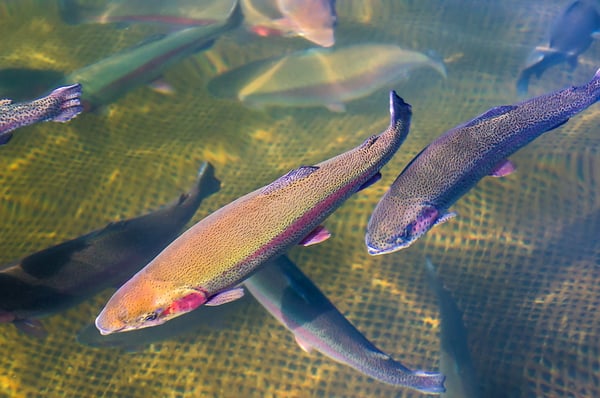what does dissolved oxygen have to do with the healthiness of water life
Dorsum to Blog
The Importance of Dissolved Oxygen in H2o for Aquaculture
As our oceans become overfished and the globe's population continues to abound in size, aquaculture has get a massive global manufacture and secure food source. The per centum of seafood supplied by the aquaculture industry has risen from a mere seven percent in 1974 to over 44 percent of all seafood consumed today. For an industry that'southward predictable to reach $242 billion in value in the adjacent four years, water quality monitoring and dissolved oxygen (Do) testing is of vital importance. In order to raise healthy, consumer-safe, and market-ready seafood, aquaculture companies must maintain precise Practise levels in their aquatic habitats—or suffer staggering consequences. It's common knowledge that oxygen is essential to terrestrial life, but information technology too plays a fundamental role in underwater ecosystems. Despite the fact that fish don't have lungs, they still require a small amount of oxygen in order to breathe and carry out essential functions. They access the oxygen they demand to survive via the h2o around them, in a form known as dissolved oxygen, or DO. Whereas plants that float on the water'south surface volition release oxygen into the atmosphere, aquatic plants, kelp, and algae that exist at lower depths have adapted to use a miniscule corporeality of sunlight to conduct photosynthesis at greater depths. Oxygen is released into the h2o past these deepwater organisms. It is also diffused into the h2o from the temper at the h2o'southward surface. The total corporeality of oxygen in the ocean and other natural water sources is much less than the amount in the atmosphere and is typically measured in parts per million (ppm). Well-nigh fish require DO levels of but v ppm or greater in order to survive. That said, larger fish demand more oxygen than smaller fish and Practise levels can vary inside a single aquatic environs based on the volume and type of plant and animal species present. For example, the suitable Practice level for shrimp culture is 3 mg/50. However, values higher than five mg/l are recommended for intensive aquaculture practices. Although five ppm doesn't seem like much, the effects of DO depletion tin be astringent. Fish that don't accept adequate oxygen resource are more prone to illness and infection, are less efficient at converting food into energy, and experience stunted growth. If oxygen levels autumn below a sure threshold, they will eventually dice. Extremely high levels of DO usually outcome from photosynthesis by a large amount of plants. Substantial uncontrolled plant growth, particularly algal bloom, is oftentimes the result of fertilizer runoff, and can also have an adverse effect on aquaculture. There are many causes of depression DO levels in water. In aquaculture, the most common cause of depression DO is overstocking or overfeeding fish in an underwater enclosure or tank. Fish need oxygen to process the nutrient they consume into fuel, so more than fish and more food inevitably means that there's more oxygen being consumed on a daily ground. If oxygen isn't beingness adequately replenished at the water's surface or by photosynthesizing organisms, Do levels will tailspin. For this reason, many aquaculture facilities will introduce photosynthesizing aquatic organisms into a farming surround to aid sustain adequate Practice levels for larger fish populations. Another common cause of depleted Practice levels is zooplankton booms and phytoplankton crashes. Whereas phytoplankton is a photosynthesizing species that creates oxygen, zooplankton are respirating organisms that subsist largely on phytoplankton and are known to increase quickly during phytoplankton blooms. By consuming phytoplankton and using Practise to respirate and convert food into free energy, an overpopulation of zooplankton can cause a depletion in the corporeality of DO available to other organisms in the aforementioned aquatic surroundings. Phytoplankton crashes tin can be caused by other natural factors likewise. For example, a sustained lack of sunlight and wind due to clouds or other obstructions can inhibit photosynthesis, killing off phytoplankton species and depleting Do levels. Practise levels can as well be influenced past pH. Whatsoever changes to the pH value of h2o tin affect how much DO the h2o can hold and transport. As you endeavour to uncover the reason for changes in DO, take frequent pH readings to make up one's mind if the two metrics are connected. Fish that fall victim to low DO levels will often seem lethargic and will spend more time at the surface of the water gulping air or in front of an aerator. They might too exhibit a loss of ambition. Because larger fish crave more oxygen to survive, they will die of oxygen depletion before minor fish and other organisms in the aforementioned environs. They might besides be quicker to brandish symptoms of oxygen depletion. Aquaculturists and fish owners should monitor Practice levels on a routine basis using a portable or inline Do controllers, transmitters, or analyzers. By tracking changes in Practise levels, you tin identify when Do is getting dangerously depression and make adjustments to your aquatic environment to increase the amount of oxygen nowadays. If your h2o quality monitor reveals low Practice, there are a variety of things you lot can practice to boost DO levels in your aquatic environment. They include: If y'all oft monitor Do levels, you should be able to correct for modest changes without having to accept more than intensive measures such equally replacing the h2o. 
Understanding Dissolved Oxygen and Why Does It Matter to Aquaculture
Causes of Low Practise in Water
Recognizing Symptoms of Low Practice in Fish
Monitoring Exercise Levels
Increasing Exercise in Water

Source: https://blog.jencoi.com/the-importance-of-dissolved-oxygen-in-water-for-aquaculture
0 Response to "what does dissolved oxygen have to do with the healthiness of water life"
Post a Comment